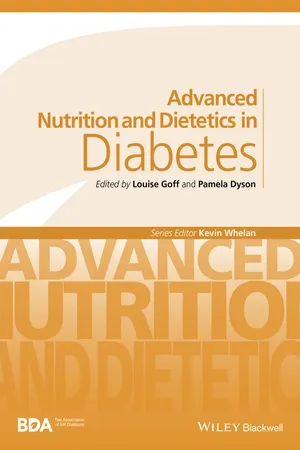
Advanced Nutrition and Dietetics in Diabetes
- English
- ePUB (mobile friendly)
- Available on iOS & Android
Advanced Nutrition and Dietetics in Diabetes
About this book
- public health efforts at diabetes prevention
- formulating nutritional guidelines for diabetes
- carbohydrates and the glycaemic index
- the management of diabetes in older people
The authors draw on their research and practical experience to offer sound guidance on best practice, ensuring that interventions are both scientifically secure and effective.
ABOUT THE SERIES
Dietary recommendations need to be based on solid evidence, but where can you find this information? The British Dietetic Association and the publishers of the Manual of Dietetic Practice present an essential and authoritative reference series on the evidence base relating to advanced aspects of nutrition and diet in selected clinical specialties. Each book provides a comprehensive and critical review of key literature in its subject. Each covers established areas of understanding, current controversies and areas of future development and investigation, and is oriented around six key themes:
- Disease processes, including metabolism, physiology, and genetics
- Disease consequences, including morbidity, mortality, nutritional epidemiology and patient perspectives
- Nutritional consequences of diseases
- Nutritional assessment, drawing on anthropometric, biochemical, clinical, dietary, economic and social approaches
- Clinical investigation and management
- Nutritional and dietary management
- Trustworthy, international in scope, and accessible, Advanced Nutrition and Dietetics is a vital resource for a range of practitioners, researchers and educators in nutrition and dietetics, including dietitians, nutritionists, doctors and specialist nurses.
Frequently asked questions
- Essential is ideal for learners and professionals who enjoy exploring a wide range of subjects. Access the Essential Library with 800,000+ trusted titles and best-sellers across business, personal growth, and the humanities. Includes unlimited reading time and Standard Read Aloud voice.
- Complete: Perfect for advanced learners and researchers needing full, unrestricted access. Unlock 1.4M+ books across hundreds of subjects, including academic and specialized titles. The Complete Plan also includes advanced features like Premium Read Aloud and Research Assistant.
Please note we cannot support devices running on iOS 13 and Android 7 or earlier. Learn more about using the app.
Information
SECTION 1
Background
Chapter 1.1
Prevalence, public health aspects and prevention of diabetes
1.1.1 Prevalence
| 2013 | 2035 | |||||
| Region | Population (20–79 y) (millions) | No. of people with DM (millions) | Diabetes prevalence (%) | Population (20–79 y) (millions) | No. of people with DM (millions) | Diabetes prevalence (%) |
| NAC | 325 | 36.7 | 9.6 | 405 | 50.4 | 9.9 |
| MENA | 375 | 34.6 | 10.9 | 584 | 67.9 | 11.3 |
| SEA | 883 | 72.1 | 8.7 | 1217 | 123.0 | 9.4 |
| EUR | 659 | 56.3 | 6.8 | 669 | 68.9 | 7.1 |
| SACA | 301 | 24.1 | 8.2 | 394 | 38.5 | 8.2 |
| WP | 1613 | 138.2 | 8.1 | 1818 | 201.8 | 8.4 |
| AFR | 408 | 19.8 | 5.7 | 776 | 41.5 | 5.3 |
| Total | 4564 | 381.7 | 8.3 | 5863 | 592.9 | 8.8 |
1.1.2 Pre-diabetes
1.1.3 Public health aspects
Economic impact of diabetes
Table of contents
- Cover
- Title Page
- Table of Contents
- Preface
- Foreword
- Editor biographies
- Contributors
- Abbreviations
- SECTION 1: Background
- SECTION 2: Dietary principles of diabetes
- SECTION 3: Type 1 diabetes
- SECTION 4: Type 2 diabetes
- SECTION 5: Pregnancy and diabetes
- SECTION 6: Diabetes in children and adolescents
- SECTION 7: Diabetes in older people
- SECTION 8: Diabetes in ethnic groups
- SECTION 9: Complications and comorbidities of diabetes
- Index
- End User License Agreement